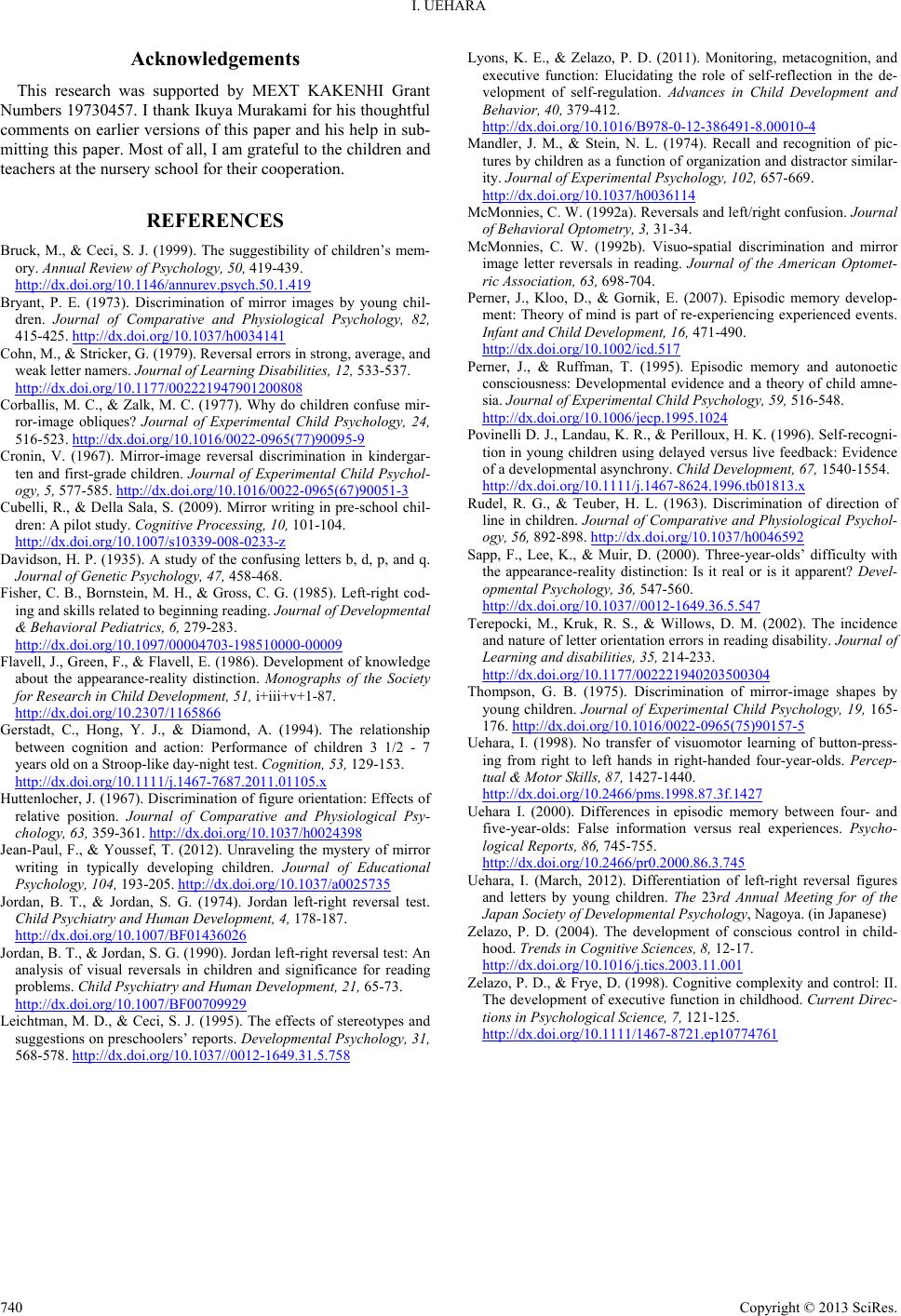
I. UEHARA
Copyright © 2013 SciRes.
740
Acknowledgements
This research was supported by MEXT KAKENHI Grant
Numbers 19730457. I thank Ikuya Murakami for his thoughtful
comments on earlier versions of this paper and his help in sub-
mitting this paper. Most of all, I am grateful to the children and
teachers at the nursery school for their cooperation.
REFERENCES
Bruck, M., & Ceci, S. J. (1999). The suggestibility of children’s mem-
ory. Annual Review of Psychology, 50, 419-439.
http://dx.doi.org/10.1146/annurev.psych.50.1.419
Bryant, P. E. (1973). Discrimination of mirror images by young chil-
dren. Journal of Comparative and Physiological Psychology, 82,
415-425. http://dx.doi.org/10.1037/h0034141
Cohn, M., & Stricker, G. (1979). Reversal errors in strong, average, and
weak letter namers. Journal of Learning Disabilities, 12, 533-537.
http://dx.doi.org/10.1177/002221947901200808
Corballis, M. C., & Zalk, M. C. (1977). Why do children confuse mir-
ror-image obliques? Journal of Experimental Child Psychology, 24,
516-523. http://dx.doi.org/10.1016/0022-0965(77)90095-9
Cronin, V. (1967). Mirror-image reversal discrimination in kindergar-
ten and first-grade children. Journal of Experimental Child Psychol-
ogy, 5, 577-585. http://dx.doi.org/10.1016/0022-0965(67)90051-3
Cubelli, R., & Della Sala, S. (2009). Mirror writing in pre-school chil-
dren: A pilot study. Cognitive Processing, 10, 101-10 4.
http://dx.doi.org/10.1007/s10339-008-0233-z
Davidson, H. P. (1935). A study of the confusing letters b, d, p, and q.
Journal of Genetic Psychology, 47, 458-468.
Fisher, C. B., Bornstein, M. H., & Gross, C. G. (1985). Left-right cod-
ing and skills related to beginning reading. Journal of Developmental
& Behavioral Pediatrics, 6, 279-283.
http://dx.doi.org/10.1097/00004703-198510000-00009
Flavell, J., Green, F., & Flavell, E. (1986). Development of knowledge
about the appearance-reality distinction. Monographs of the Society
for Research in Child Development, 51, i+iii+v+1-87.
http://dx.doi.org/10.2307/1165866
Gerstadt, C., Hong, Y. J., & Diamond, A. (1994). The relationship
between cognition and action: Performance of children 3 1/2 - 7
years old on a Stroop-like day-night test. Cognition, 53, 129-153.
http://dx.doi.org/10.1111/j.1467-7687.2011.01105.x
Huttenlocher, J. (1967). Discrimination of figure orientation: Effects of
relative position. Journal of Comparative and Physiological Psy-
chology, 63, 359-361. http://dx.doi.org/10.1037/h0024398
Jean-Paul, F., & Youssef, T. (2012). Unraveling the mystery of mirror
writing in typically developing children. Journal of Educational
Psychology, 104, 193-205. http://dx.doi.org/10.1037/a0025735
Jordan, B. T., & Jordan, S. G. (1974). Jordan left-right reversal test.
Child Psychiatry and Human Development, 4, 178-187.
http://dx.doi.org/10.1007/BF01436026
Jordan, B. T., & Jordan, S. G. (1990). Jordan left-right reversal test: An
analysis of visual reversals in children and significance for reading
problems. Child Psychiatry and Human Development, 21, 65-73.
http://dx.doi.org/10.1007/BF00709929
Leichtman, M. D., & Ceci, S. J. (1995). The effects of stereotypes and
suggestions on preschoolers’ reports. Developmental Psychology, 31,
568-578. http://dx.doi.org/10.1037//0012-1649.31.5.758
Lyons, K. E., & Zelazo, P. D. (2011). Monitoring, metacognition, and
executive function: Elucidating the role of self-reflection in the de-
velopment of self-regulation. Advances in Child Development and
Behavior, 40, 379-412.
http://dx.doi.org/10.1016/B978-0-12-386491-8.00010-4
Mandler, J. M., & Stein, N. L. (1974). Recall and recognition of pic-
tures by children as a function of organization and distractor similar-
ity. Journal of Experimental Psychology, 102, 657-669.
http://dx.doi.org/10.1037/h0036114
McMonnies, C. W. (1992a). Reversals and left/right confusion. Journal
of Behavioral Optometry, 3, 31-34.
McMonnies, C. W. (1992b). Visuo-spatial discrimination and mirror
image letter reversals in reading. Journal of the American Optomet-
ric Association, 63, 698- 704.
Perner, J., Kloo, D., & Gornik, E. (2007). Episodic memory develop-
ment: Theory of mind is part of re-experiencing experienced events.
Infant and Child Development, 16, 471-490.
http://dx.doi.org/10.1002/icd.517
Perner, J., & Ruffman, T. (1995). Episodic memory and autonoetic
consciousness: Developmental evidence and a theory of child amne-
sia. Journal of Experimental Child Psychology, 59, 516-548.
http://dx.doi.org/10.1006/jecp.1995.1024
Povinelli D. J., Landau, K. R., & Perilloux, H. K. (1996). Self-recogni-
tion in young children using delayed versus live feedback: Evidence
of a developmental asynchrony. Child Development, 67, 1540-1554.
http://dx.doi.org/10.1111/j.1467-8624.1996.tb01813.x
Rudel, R. G., & Teuber, H. L. (1963). Discrimination of direction of
line in children. Journal of Comparative and Physiological Psychol-
ogy, 56, 892-898. http://dx.doi.org/10.1037/h0046592
Sapp, F., Lee, K., & Muir, D. (2000). Three-year-olds’ difficulty with
the appearance-reality distinction: Is it real or is it apparent? Devel-
opmental Psychology, 36, 547-560.
http://dx.doi.org/10.1037//0012-1649.36.5.547
Terepocki, M., Kruk, R. S., & Willows, D. M. (2002). The incidence
and nature of letter orientation errors in reading disability. Journal of
Learning and disabilities, 35, 214-233.
http://dx.doi.org/10.1177/002221940203500304
Thompson, G. B. (1975). Discrimination of mirror-image shapes by
young children. Journal of Experimental Child Psychology, 19, 165-
176. http://dx.doi.org/10.1016/0022-0965(75)90157-5
Uehara, I. (1998). No transfer of visuomotor learning of button-press-
ing from right to left hands in right-handed four-year-olds. Percep-
tual & Motor Skills, 87, 1427-1440.
http://dx.doi.org/10.2466/pms.1998.87.3f.1427
Uehara I. (2000). Differences in episodic memory between four- and
five-year-olds: False information versus real experiences. Psycho-
logical Reports, 86, 745-755.
http://dx.doi.org/10.2466/pr0.2000.86.3.745
Uehara, I. (March, 2012). Differentiation of left-right reversal figures
and letters by young children. The 23rd Annual Meeting for of the
Japan Society of Developmental Psychology, Nagoya. (in Japanese)
Zelazo, P. D. (2004). The development of conscious control in child-
hood. Trends in Cognitive Sciences, 8, 12-17.
http://dx.doi.org/10.1016/j.tics.2003.11.001
Zelazo, P. D., & Frye, D. (1998). Cognitive complexity and control: II.
The development of executive function in childhood. Current Direc-
tions in Psychological Science, 7, 121-125.
http://dx.doi.org/10.1111/1467-8721.ep10774761